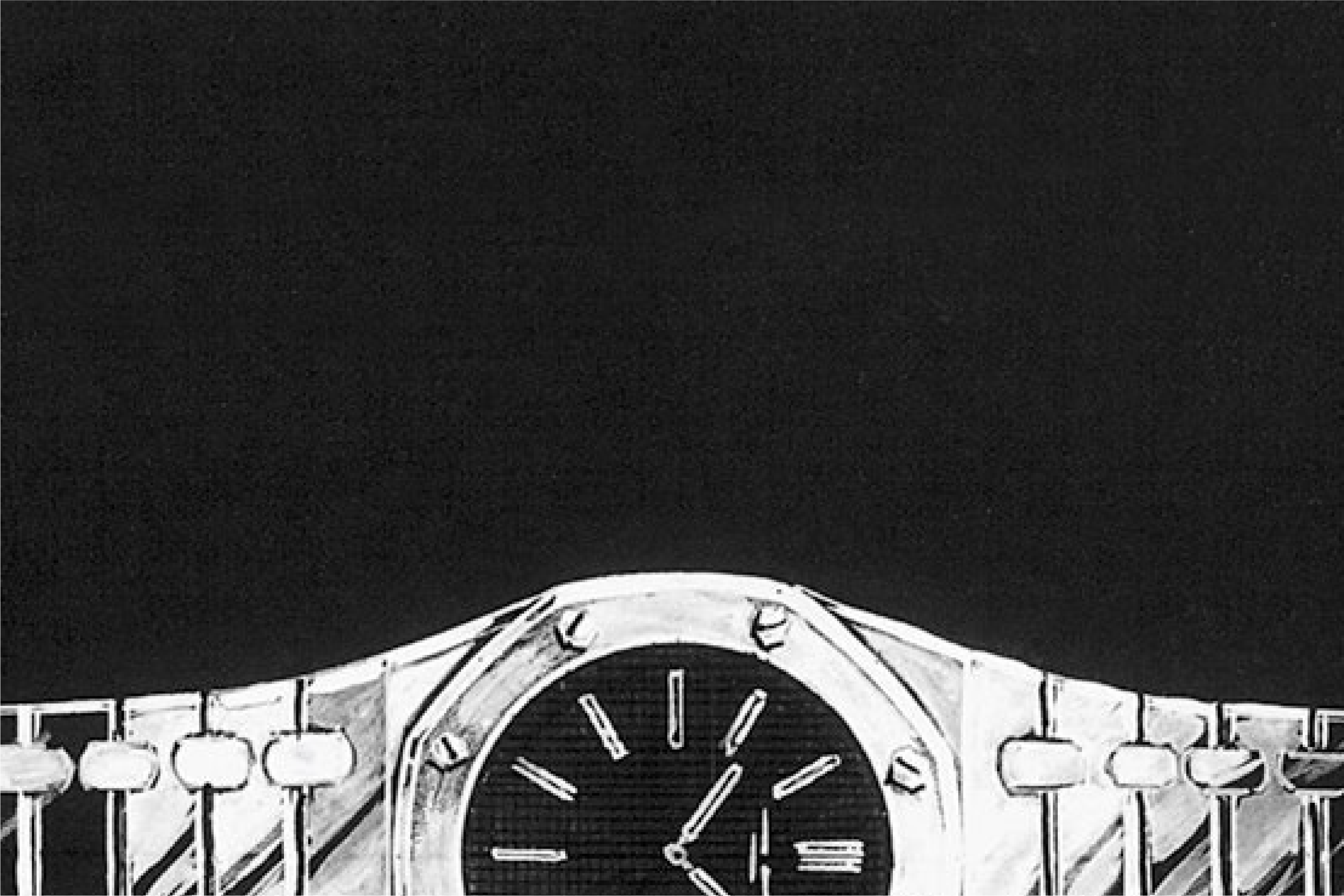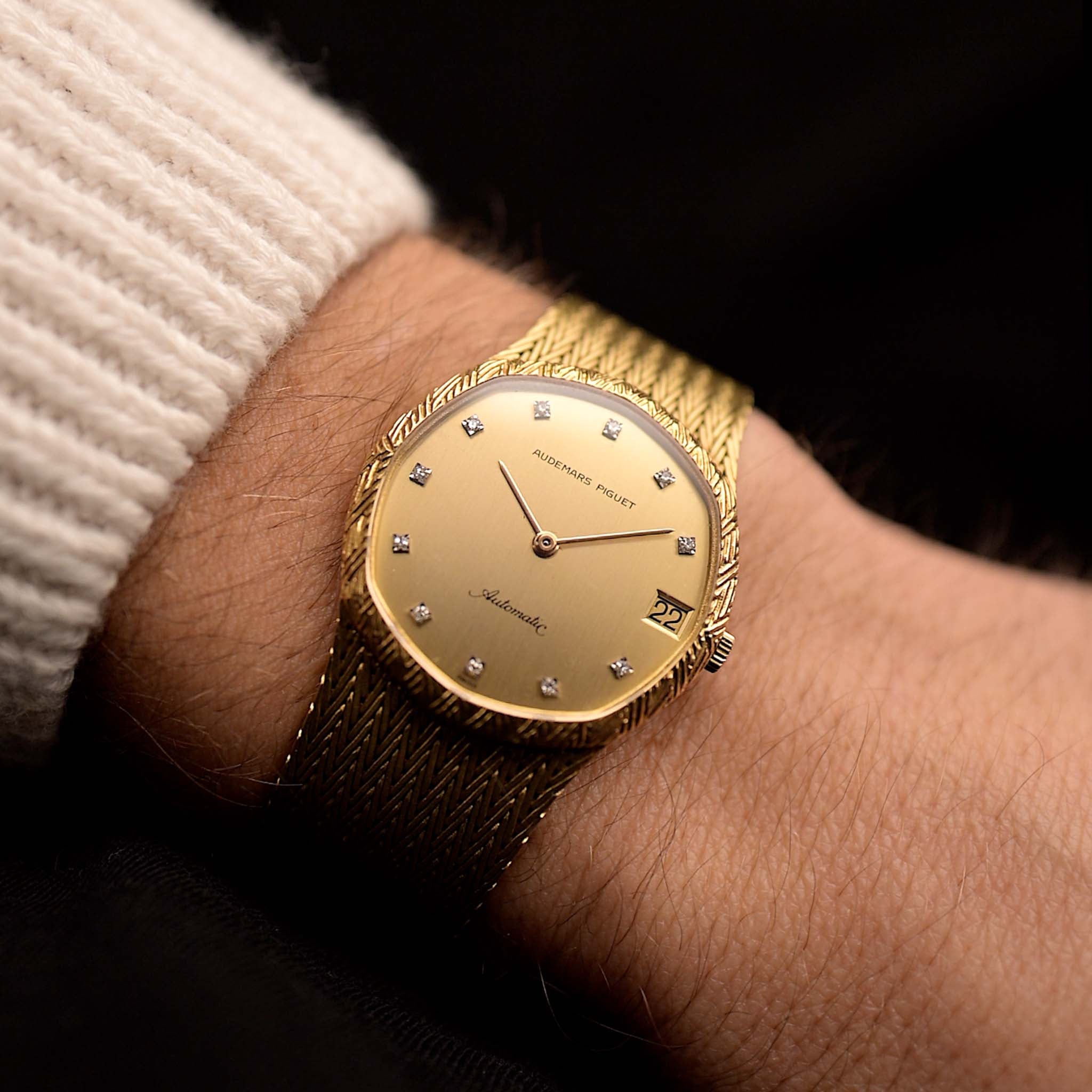The legend, the myth, the icon... the Audemars Piguet Royal Oak 5402. Inspired by nautical themes the Royal Oak sported an octagonal bezel, visible screws and gaskets. The design was the incarnation of a traditional diver’s helmet in wristwatch-shape. Adding to the daring presence it also featured a blue tapisserie dial, “Jumbo” 38.8mm case dimensions and an integrated tapered steel bracelet in unheard of complexity. The epiphany of the Luxury Steel Sports Watch.
November 23, 2021
Taking Roots in Modern Horology - The Royal Oak
 Marcus Siems @siemswatches
Marcus Siems @siemswatches
Collector, Author, Data Analyst
The Audemars Piguet Royal Oak. I could stop here and everyone who just as much as shared the room with a watch collector would know what I’m talking about. It is the definition of the modern luxury steel sports watch, a dream in steel and blue. But let’s turn back the time a bit, 50 years to be exact. As the story begins in 1971 when Audemars Piguet (AP) asked a young designer – the legendary Gerald Genta – to create an unprecedented steel watch[1-4]. And as the legend goes on the first sketch of the Royal Oak was conceived overnight.
 The original 1971 Gerald Genta design.
The original 1971 Gerald Genta design.
From the release in 1972 onward the Royal Oak has been a revolution on the wrist, an icon ahead of its time. A watch that single-handedly created a new watchmaking genre, the luxury steel sports watch. However, as novel as this design has been as a whole, several individual features of it were of course common during the 1970s and others were destined to become classic design themes in the years after. So an interesting question to ask then is what time does the Royal Oak represent? When does it fit in best?
With the data we have now – an overview of watches offered on the vintage market[5] – we can frame the Royal Oak in time. Here, I analyzed over 4000 watches from the last century, pieces ranging from 1940 to 2000 to answer this questions. With simple data analysis approaches we can try to better understand the mythical Royal Oak.
 Gerald Genta, the mastermind industrial watch designer and father of Universal Geneves Polerouter, asked to help out the quartz-riddled Audemars Piguet brand. Photo @goldammer.me
Gerald Genta, the mastermind industrial watch designer and father of Universal Geneves Polerouter, asked to help out the quartz-riddled Audemars Piguet brand. Photo @goldammer.me
Before we dive into the features of the Royal Oak we’ll have a look at the foundation this design was built upon. Not surprisingly, several features of this iconic timepiece were inspired by the common motifs of the contemporary taste. However, the Royal Oak seemed to have always been adding a twist on the 1972 zeitgeist.
Inspired by nautical themes the Royal Oak sported an octagonal bezel, visible screws and gaskets. The design was the incarnation of a traditional diver’s helmet in wristwatch-shape. Adding to the daring presence it also featured a blue tapisserie dial, “Jumbo” 38.8mm case dimensions and an integrated tapered steel bracelet in unheard of complexity.
 The concept of an unheard of bezel design made from high-grade steel and finished by hand. Photo courtesy of Audemars Piguet©.
The concept of an unheard of bezel design made from high-grade steel and finished by hand. Photo courtesy of Audemars Piguet©.
Now how can we categorize the Royal Oak 5402? It’s the first luxury steel sports watch. Well, that’s quite the sub-category of a sub-category of watches. So not going into too much of a niche we can ask what is a sports watch? The sports or dress casual watches are the natural hybrid between sturdy tool-watches and classic dress pieces. They are the all-rounder of the watch world.
 With the help of the Oyster Case (1926) Rolex paved the way for most modern dress casual and sports watches. Photo @goldammer.me
With the help of the Oyster Case (1926) Rolex paved the way for most modern dress casual and sports watches. Photo @goldammer.me
This category of horology can at least be dated back to the first water- and shock-resisting Rolex Oyster models of the late 1920s[6] and developed further into the classic Omega Seamaster collections of the late 1940s[7,8]. Over the following years the evolution continued and the popularity increased. In the birth year of the Royal Oak, 1972, this one-for-all-occasions watch type is already the most popular on the market.
 Figure 1. Distribution of sports watches from 1940 to 2000 and the distribution of watch types from 1971-1973. The sports- or dress casual watches are the most common theme of the early 1970s watch world. In the years following the 5402 release the sports watch market share is further increasing until its peak in 1980.
Figure 1. Distribution of sports watches from 1940 to 2000 and the distribution of watch types from 1971-1973. The sports- or dress casual watches are the most common theme of the early 1970s watch world. In the years following the 5402 release the sports watch market share is further increasing until its peak in 1980.
The sports watch took over a market that is extremely versatile at the time. The sports watches were clearly trending, particularly in the years to come. It was the middle ground that everyone could agree upon: Not too much tool like the chronograph or the dive watch and also not too dressy. Just the right fit for every day and every activity.
And now let’s see where the “luxury” in luxury sports watch comes into play. Back in 1972, as probably is still nowadays, the prototypical dress casual watch was the Rolex Datejust. In 1970 the classic DJ was sold for around 250-350$[9], the Royal Oak 5402 on the other hand came in at the enormous amount of 3000$[2]! But how could Audemars Piguet justify such a price when even most gold watches were way more affordable?
 The heavy 1970s favorite for the classic all-rounder watch: The Rolex Datejust 1601. Photo @goldammer.me
The heavy 1970s favorite for the classic all-rounder watch: The Rolex Datejust 1601. Photo @goldammer.me
First, it was never meant to be a mass-market watch. It could cost more because it was addressed to a specific audience looking for the It-factor. Second, the special something was the way the material was handled and finished. It looked like something sporty at first glance but the watch was actually Haute Horologie.
The Royal Oak was never about the material per se but how this material was used. Supposedly, the finishing procedures were so complex at first that the initial prototype was built from white gold – because gold could be handled easier than the high-grade steel used for the 5402[1]. The tapisserie on the dial is an elaborate finishing that takes countless hours to make and it takes the most advanced masters of its craft to execute it.
And third, the Royal Oak 5402 was also technically on top of its class. It was just 7mm slim mainly due to its ultra-thin Calibre 2121. The movement was based on the JLC Cal. 920[10], and originally financed and supported by AP, Patek Philippe & Vacheron Constantin. With only 2.45mm Jaeger-LeCoultres Calibre 920 was the thinnest full-rotor automatic movement of the time to which AP added the date complication for the 5402 (and additional 0.6mm).
 Audemars Piguet Vintage Advertisement: "Quite Simply The Royal Oak."[11]
Audemars Piguet Vintage Advertisement: "Quite Simply The Royal Oak."[11]
All these things combined make clear why the Royal Oak has not just been a sports watch like what could otherwise be found on the market. The 5402 may have been built upon this (then) 50-year-old horological classic but it added its own twist. But that is only the genre, there are way more details of the design that we need to speak about. What makes this piece special can also be found on the dial.
All about the Royal Oak 5402 here:
Part I - Taking Roots in Modern Horology
Part II - A Trendsetting Dial
Part III - A Creative Dial
Part IV - The Bolt Case Design
Part V - Design Heritage
References
[1] History of the Audemars Piguet Royal Oak; Alessandro Mazzardo, TimeAndWatches;
https://www.timeandwatches.com/p/history-of-audemars-piguet-royal-oak.html
[2] How the Audemars Piguet Royal Oak Made History; Adam Craniotes, Gear Patrol;
https://www.gearpatrol.com/watches/a79909/audemars-piguet-royal-oak/
[3] Audemars Piguet: the real origin story; Robin Swithinbank, GQ UK;
https://www.gq-magazine.co.uk/watches/article/audemars-piguet-royal-oak-history
[4] Warum die Royal Oak von Audemars Piguet ein echter Uhren-Klassiker ist; Redaktion, WatchTime;
[5] Watches from Chrono24, extracted 2020 Nov. 29th; Karlsruhe, Germany;
[6] Rolex Fluted Bezel: Complete History; Millenary Watches;
[7] A Brief History of the Omega Seamaster; Anthony Tyme, Vintage Portfolio;
https://www.vintage-portfolio.com/de/a-brief-history-of-the-omega-seamaster/
[8] Omega Seamaster, eine Erfolgsgeschichte, die ihresgleichen sucht; Zeitenblick;
https://www.zeitenblick.at/omega-seamaster-history/
[9] Rolex Price Evolution; Sheldon Smith, Minus4Plus6;
https://www.minus4plus6.com/PriceEvolution.php
[10] I Am Legend – The Jaeger-LeCoultre Calibre 920; Wei Koh, RevolutionWatch;
https://revolutionwatch.com/i-am-legend-the-jaeger-lecoultre-calibre-920/
[11] Ad Patina - Audemars Piguet; Nick, Ad Patina;
https://www.adpatina.com/audemars-piguet
All rights on text and graphics reserved to the Author.




























Leave a comment